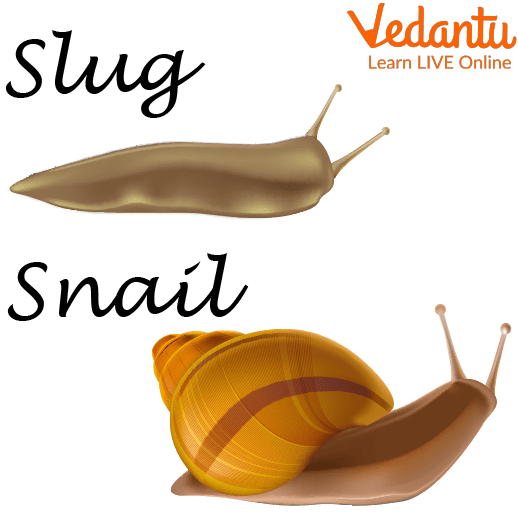




Snail and Slug Features: Comparison Chart & Easy Examples
Gastropods include both snails and slugs. Slugs are exposed to the weather because they lack the coiled shell that snails have. Snails and slugs differ from one another not just in anatomy but also in habitat, feeding, lifespan, and behaviour. The phylum Mollusca includes the Gastropoda class, which includes the slug and the snail. The term derives from the Greek words gastro (stomach) and podos (feet). Gastropods are often aquatic creatures.

Decaying Leaves
Snails and slugs are often found on dry land. However, both species can occasionally be found in water, even for brief periods. Both creatures leave behind a slime trail. They may move across the ground thanks to mucus. Both types of life can become dangerously dehydrated if they lose moisture to dry soil.
Anatomy of the Slug and Snail
The main distinction between the two species is that the snail has an obvious shell while the slug does not. The snail has a large enough shell for it to duck into for protection. Some snails can retract their shells completely. Slugs lack a defensive shell or mobile house. Slugs commonly employ a vestigial internal shell. Calcium is kept in it for later use. The animal's soft tissue runs the risk of desiccating without a protective shell.
Following are the Difference Between Snail and Slug:
Snail vs Slug: Movement
Snails move around by using a muscular foot called a "foot" that sticks to the ground, while these animals move forward. Slugs lack a muscular foot and they use their body to pull themselves forward on their belly or sides. Slugs go backwards or sideways when needed. But snails cannot do this because the snail's body is covered with a shell and its foot sticks only in one place.
Snail vs Slug: Speed
Different snails and slugs move at various speeds. The average snail can move at a speed of 1 mm/s. It moves more quickly than other slugs. Some snails don't even move at all.
Snail vs Slug: Habitat
Slugs can easily, if slowly, fit into the smallest openings thanks to their lack of a rear shell and the capacity to compress themselves. To their benefit, they make use of loose tree bark, stone slabs, and wooden planks.
Snails immediately retreat to their shells, especially when there are nearby natural predators. Some snails can seal their shells and retract for added defence.

Snail vs Slug
Snail vs Slug: Cuisine
Snails are a delicacy in many nations, but particularly in France. Many upscale restaurants serve cooked land snails as an appetiser called escargot. Large land snails are the major source of the dish's ingredients, largely because they are very nutritious, and it is best to avoid using sea snails because they can be poisonous to people. Slugs may also be eaten.
Summary
Snails and slugs belong to the same class and they both have many similarities like their movement, their food, etc. Snail bodies are covered with a shell that protects them from danger, while slug bodies are not covered with the shell. The shell of snails are much more like an envelope that protects them from predators including humans and can expand when disturbed to increase their size. Snails and slugs both can live in aquatic or terrestrial habitats. They feed by propelling food from the mouth into their intestines where it is digested. Both snails and Slugs are very common and can be found almost everywhere on land and water.
FAQs on Difference Between Snail and Slug
1. What is the main difference between a snail and a slug?
The most significant difference between a snail and a slug is the presence of an external shell. A snail possesses a visible, coiled shell on its back that it can retract into for protection. In contrast, a slug is a gastropod that either has no shell, a very small internal shell, or a reduced external shell.
2. Are slugs just snails that have lost their shells?
From an evolutionary perspective, yes. Slugs are not individual snails that have lost their shells; rather, they have evolved from snail-like ancestors over millions of years. This evolutionary process involved the gradual reduction and eventual internalisation or complete loss of the external shell. This adaptation allows slugs to access habitats, such as underground burrows, that are inaccessible to shelled snails.
3. What are the key similarities between snails and slugs?
Despite their differences, snails and slugs share many biological traits as both are gastropod molluscs. Key similarities include:
- Soft Bodies: Both have soft, unsegmented bodies without a backbone.
- Muscular Foot: They both move using a large, muscular foot that glides on a layer of mucus.
- Tentacles: Both typically have two pairs of retractable tentacles on their heads used for seeing and sensing their environment.
- Diet: They have similar diets, primarily feeding on plants, fungi, and decaying organic matter.
4. How do snails and slugs protect themselves from predators and dehydration?
Their methods of protection are a direct result of their anatomy. A snail's primary defence is its hard, external shell, which provides a physical barrier against predators and helps prevent moisture loss. A slug, lacking this protection, relies on other strategies. It produces a thick, slimy mucus that can be unpalatable to some predators. Its flexible body also allows it to squeeze into tight cracks, under rocks, and into soil to hide and stay moist.
5. What are the main external parts of a slug’s body?
A slug's body is simpler in appearance than a snail's but has distinct parts:
- Mantle: A saddle-shaped tissue layer on the back that covers the internal organs.
- Pneumostome: A breathing pore, usually located on the right side of the mantle.
- Tentacles: Two pairs on the head for sight and sensory input.
- Foot: The flat, muscular underside responsible for locomotion.
- Keel: A ridge running along the back of some slug species.
6. Why are both snails and slugs considered agricultural pests?
Both are considered significant pests in agriculture and gardening because they feed on a wide range of plants. They can cause considerable damage by eating the leaves, stems, flowers, roots, and fruits of crops. Their feeding activity is most prominent during damp, cool conditions, and they can be particularly destructive to young seedlings and leafy vegetables.
7. How does the absence of a shell affect a slug’s habitat and behaviour compared to a snail?
The lack of a shell makes slugs more susceptible to dehydration (drying out). Consequently, slugs are generally restricted to very moist environments and are most active at night or during rainy weather. Snails, with the protection of their shells, can tolerate slightly drier conditions. Furthermore, a slug's shell-less body allows it to be more flexible and squeeze through small openings, giving it access to different hiding spots.
8. Can snails or slugs be dangerous to humans or pets?
While not directly aggressive, slugs and snails can pose an indirect health risk. They can be carriers of parasites, most notably the rat lungworm, which, if ingested (for example, by eating unwashed produce they have crawled on), can cause a rare but serious type of meningitis in humans and pets. Therefore, it is important to wash vegetables thoroughly and maintain good hygiene after handling them.









